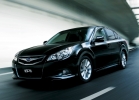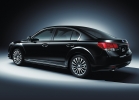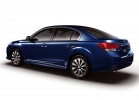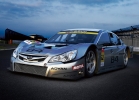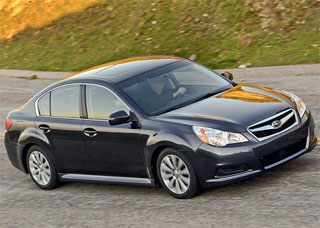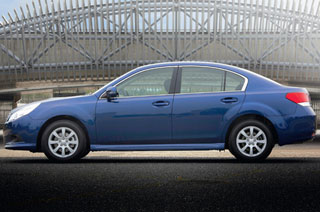Subaru Legacy West drive sedan since 2009 sedan
Test drive a/m Subaru Legacy after modernization
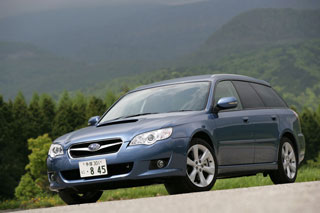 Technical characteristics of the Legacy Touring Wagon 2.0 GT model:
Technical characteristics of the Legacy Touring Wagon 2.0 GT model: Length 4680 mm x width 1730 mm x height 1470 mm.
Wheel base: 2670 mm.
Machine weight: 1480 kg.
Drive: all -wheel drive 4wd
Engine: 2-liter, 4-cylinder with horizontal cylinder location, DOHC Twinturbo, maximum developed power 191 KW (260 hp) at 6600 rpm, the largest torque 343 NM (35.0 kg/m/m (35.0 kg/m (35.0 kg/m ) at 2000 rpm.
Gearbox: 5-speed with automatic switching
Machine price: 3 million 606 thousand yen.
Not at all small modernization.
What's new in the Legacy Touring Wagon car after he survived the next small modernization? Anyone who carefully monitors all the novelties leaving the Subaru design bureau will immediately say: the machine began to be equipped with a Si-Drive system. I knew little about this novelty until I heard a representative of the company's technical group performed at a briefing before the start of test trips. Having received a brief explanation, at first I did not experience particularly positive emotions. It seems that I thought, that we are talking about a typical case when a technical innovation is needed only to show: engineers constantly think about improving their brainchild. So to speak, technological progress in order to demonstrate technical potential! But what has been done is done, now we will see what will come of it in practice. Thinking in this way, I suddenly remembered that I did not always feel complete satisfaction from how individual representatives of the Legacy model range showed themselves in the past. And if so, then why not assume that this is an innovation measure aimed at eliminating the shortcomings available in these machines? No, not for the sake of demonstrating their technical achievements, the authors of the Legacy project started this pre -equipment! After all, all the already held owners of Legacy cars already know the price of the Subaru car brand. So, nevertheless, the adoption of the SI-Drive system is due to far-reaching plans!
 Meanwhile, the developers of this system argue that their goal is to instill a taste for the control of the Legacy machine as large as possible drivers, as they say, to everyone and everyone. And for this you must definitely make the car as simple as possible in handling. It was for this purpose that the last small modernization was conceived and carried out, which, judging by the result, was not so small. In fact, there has never been such that the Legacy model after the next low modernization, which is usually limited by small alterations of a cosmetic nature, has changed in such a fundamentally. In short, the car was made technically more perfect, but it took this in order to gain the trust of new potential buyers.
Meanwhile, the developers of this system argue that their goal is to instill a taste for the control of the Legacy machine as large as possible drivers, as they say, to everyone and everyone. And for this you must definitely make the car as simple as possible in handling. It was for this purpose that the last small modernization was conceived and carried out, which, judging by the result, was not so small. In fact, there has never been such that the Legacy model after the next low modernization, which is usually limited by small alterations of a cosmetic nature, has changed in such a fundamentally. In short, the car was made technically more perfect, but it took this in order to gain the trust of new potential buyers. The list of changes made to the car is really large enough. In addition to the emergence of the SI-Drive system, the consistent improvement of the engine is noteworthy, aimed, in particular, to the maximum possible reduction in harmful emissions into the atmosphere. Without these and other large -scale improvements of the power unit, it is unlikely that Legacy is unlikely to count on a cloudless future for the LEGACY.
If we consider the power line of the new car, then, first of all, it should be noted that the engine with a turbocharged was in conjunction with a 6-speed hand gearbox. By the way, earlier this box was used together with a 3-liter engine in the Legacy 3.0 R model. So, before rearranging it on a 2.0 GT car, it was decided to increase the gear rates of the second, third and fourth speeds. The box converted in this way then turned out to be a new model involved in the 3.0 r model.
 In the Subaru Legacy car in configuration B with a turbo engine, the same 6-speed hand gearbox works with a differential of increased LSD friction in the rear bridge, complemented by a torque sensor. In the engine turbocharger, the shape of the vortex chamber is changed to improve the characteristics of the air flow. It is also interesting to note that in all cars with turbocharges and hand gearboxes it was decided to abandon the turbines produced by Mitsubishi in favor of IHI brand equipment. In a word, if you take into account only those changes that are visible immediately, they will have to be listed for a long time.
In the Subaru Legacy car in configuration B with a turbo engine, the same 6-speed hand gearbox works with a differential of increased LSD friction in the rear bridge, complemented by a torque sensor. In the engine turbocharger, the shape of the vortex chamber is changed to improve the characteristics of the air flow. It is also interesting to note that in all cars with turbocharges and hand gearboxes it was decided to abandon the turbines produced by Mitsubishi in favor of IHI brand equipment. In a word, if you take into account only those changes that are visible immediately, they will have to be listed for a long time. A number of changes aimed at increasing its strength were also made to the body design. In particular, an additional steel sheet of greater thickness is provided between the suspension of the front wheels and the front line of the body to enhance the hardness of the body. In addition, in the suspension of the rear wheels it was decided to slightly change the geometry of the suspension. You must admit that such meticulousness to the little things I want to call Mania. But without proper attention to small details, counting on success when solving the task is sometimes difficult.
The SI-Drive system changes the character of a turbo engine.
In short, the operation of the SI-Drive system can be represented as follows. So, the car has three driving modes S-SPORT, S#-SPort ShaRP and I-Intelligent, which are selected using a switch located on the central console of the front panel of the cabin. The S mode is considered basic, so after starting the engine, it is he who automatically turns on. If we draw an analogy with the Legacy of the previous type, then this mode almost fully corresponds to the Power mode.
 However, you just have to turn the handle of the selector switch to the right, how the S#mode will work. It allows you to control the machine in a purely sports manner. In particular, in this mode, the engine begins to respond to the accelerator pedal almost instantly. Moreover, when the engine speed reaches 3500 rpm, and, therefore, its torque increases, a sharp engine reaction leads to an equally sharp increase in speed. Moreover, the intensity of acceleration is significantly higher than when the engine operates in the range of so -called average working revolutions. And finally, turning the selector, the driver includes mode I. This mode can be called as low power mode (Low Power Mode). Intelligent Mode, in particular, is characterized by a decrease in engine acceptance. That is, the engine reacts to the accelerator pedal not so intensively. This, of course, leads to the fact that the rate of speed occurs at a slow rate. In other words, the principle of operation of the SI-Drive system is reduced to the influence on the electronic control unit (ECU), mainly on that part that controls the work of the throttle. As a result of this, the engine begins to behave this or otherwise.
However, you just have to turn the handle of the selector switch to the right, how the S#mode will work. It allows you to control the machine in a purely sports manner. In particular, in this mode, the engine begins to respond to the accelerator pedal almost instantly. Moreover, when the engine speed reaches 3500 rpm, and, therefore, its torque increases, a sharp engine reaction leads to an equally sharp increase in speed. Moreover, the intensity of acceleration is significantly higher than when the engine operates in the range of so -called average working revolutions. And finally, turning the selector, the driver includes mode I. This mode can be called as low power mode (Low Power Mode). Intelligent Mode, in particular, is characterized by a decrease in engine acceptance. That is, the engine reacts to the accelerator pedal not so intensively. This, of course, leads to the fact that the rate of speed occurs at a slow rate. In other words, the principle of operation of the SI-Drive system is reduced to the influence on the electronic control unit (ECU), mainly on that part that controls the work of the throttle. As a result of this, the engine begins to behave this or otherwise. Above, I mentioned that it was not completely satisfied with the way representatives of the LEGACY model range behave sometimes. I meant cars that are equipped with a turbocharged engine. The essence of this displeasure is that at high speed the engine reacts very sharply to the accelerator pedal. Until the last low modernization, the EJ20 with turbocharges provided relatively smooth acceleration if the rotation speed of the crankshaft did not exceed 4000 rpm, so it was quite easy to control with it. But as soon as the engine was overcome by this 4 thousandth line, all the smoothness went somewhere, and at the slightest pressing of the gas pedal, the car sharply threw forward. It is not that this process can be called uncontrollable, but he nevertheless introduced a certain imbalance in the control order.
I can understand that in order to give the engine to really give out 280 horsepower, the designers had to come to terms with this super-reception at high speeds. And in return at low speeds, make him be a cord. But the fact remains: the nature of the Legacy car with a turbocharged former sample was distinguished by some duality.
 But now, after partial modernization, the Si-Drive system appeared at the disposal of the driver. What does this mean in practice? In S mode, this relative restraint, which was characteristic of the Legacy car with turbocharges at low speeds, is also supported in high speeds in the current model. There is an opinion that the ideal version of the Legacy car is a sports sedan (or station wagon). So, now this ideal version of Legacy can be forced to behave not so sharply even when the engine works at high speeds. But we should not forget that there is also the S#mode, in which the Legacy car demonstrates all its potential, which is initially laid in it. And this, in particular, means a high reaction rate to the accelerator pedal. Thus, by varying these two modes, the driver can divide into two parts that which used to seem one.
But now, after partial modernization, the Si-Drive system appeared at the disposal of the driver. What does this mean in practice? In S mode, this relative restraint, which was characteristic of the Legacy car with turbocharges at low speeds, is also supported in high speeds in the current model. There is an opinion that the ideal version of the Legacy car is a sports sedan (or station wagon). So, now this ideal version of Legacy can be forced to behave not so sharply even when the engine works at high speeds. But we should not forget that there is also the S#mode, in which the Legacy car demonstrates all its potential, which is initially laid in it. And this, in particular, means a high reaction rate to the accelerator pedal. Thus, by varying these two modes, the driver can divide into two parts that which used to seem one. Okay, but then the question arises: how should I consider the regime I? Most likely, it is needed in order to use the engine half its power, to achieve complete calm from him, so as not to be nervous at the wheel. By the way, on the day when I was supposed to master the Fuji Speedway track behind the wheel of a new -sample car, it rained over this track. It is unnecessary to say that moving along the ring track, now and then completely squeezing the accelerator pedal when the asphalt covered with water film under the wheels is quite difficult. And go. And now I only had to switch to mode I, how to control the machine became immeasurably easier.
On steep turns, I acted with a gas pedal, not too ceremony with it, but the throttle was in no hurry to react to my teams. Therefore, it was also not possible to force the car to go to the yuz. As for the S or S#modes, when they are turned on, it was necessary to constantly monitor not to be encouraged. The speed, of course, increased at a slow rate, but there were no irritating delays with transitions from one speed range to another. Therefore, we can say that the car moved briskly and without visible voltage. Initially, the goal was to make sure that the car did not twitch when you have to move along the city streets. Therefore, point I was included in the operating menu. At the same time, no one is safe from the surprises of nature in the form of rain or snow. And then it doesn’t matter where, but you have to move with more caution, forcing the motor to work at half of its power. Then you put a throttle under hard electronic control, and that’s all, you can not be afraid that the turbocharged engine will show its agility at the most inopportune moment. Such a SI-Drive system found management potential.
High potential, which anyone will like to manage
I devoted all the previous pages of my report on testing races to the modernized Subaru Legacy Touring Wagon car equipped with the EJ20 brand engine. It was on the example of this model that I tried to tell about what is
 si-Drive system. However, we should not forget that there is also a Legacy Touring Wagon 3.0 R model, on which there is a simple horizontal-opposition engine with a 3-liter working volume. How does the SI-Drive system work there? I answer: the action of the regime S in the same way distinguishes it from the S#mode, as in a car with a turbocharged. That is, if the driver has turned on the S mode, then he receives a rather acceptable machine in the control, which, nevertheless, does not break forward too much and does not force to be nervous. On the other hand, by choosing the S#mode, you can force the car to respond to the gas pedal very sharply, which feels comparable with the reaction of a 3-liter 6-cylinder V-shaped atmospheric engine. But if you enable mode I, then the machine will behave as if it was driven by a motor with a working volume of about 2.5 liters, which, of course, is characterized by an increased torque. That is, the engine will act adulthly, and its smoothness will be similar to the one that a type V6 type usually demonstrates.
si-Drive system. However, we should not forget that there is also a Legacy Touring Wagon 3.0 R model, on which there is a simple horizontal-opposition engine with a 3-liter working volume. How does the SI-Drive system work there? I answer: the action of the regime S in the same way distinguishes it from the S#mode, as in a car with a turbocharged. That is, if the driver has turned on the S mode, then he receives a rather acceptable machine in the control, which, nevertheless, does not break forward too much and does not force to be nervous. On the other hand, by choosing the S#mode, you can force the car to respond to the gas pedal very sharply, which feels comparable with the reaction of a 3-liter 6-cylinder V-shaped atmospheric engine. But if you enable mode I, then the machine will behave as if it was driven by a motor with a working volume of about 2.5 liters, which, of course, is characterized by an increased torque. That is, the engine will act adulthly, and its smoothness will be similar to the one that a type V6 type usually demonstrates. Of course, the differences in the behavior of the Legacy Touring Wagon machine with an ordinary engine are not as clearly expressed as in a car with a boost. Nevertheless, I clarified the following for myself: if the driver has to drive a car with increased speed for a rather long time, then the sin -free section of the road is more appropriate, then a winding section of the road is found, then to maintain the previous pace of the ride should go to Sport Sharp mode. But the thing is done and you, tired, but satisfied, go back. In order not to injure your nervous system once again, it is better to choose the I mode, and calmly follow the purpose. Moreover, this is the most profitable regime in terms of fuel savings.
 It should be noted once again: the list of changes that were made to the Legacy Touring Wagon model during the current low modernization is not limited only to the subjugation of the machine by the SI-Drive system. If, for example, to compare the subjective sense of comfort that the driver at the wheel of Legacy is a new and old model, then in the first case, comfort seems more honed. It should also be borne in mind that the suspension of the passenger station wagon is slightly different in its settings from the suspension of the sedan.
It should be noted once again: the list of changes that were made to the Legacy Touring Wagon model during the current low modernization is not limited only to the subjugation of the machine by the SI-Drive system. If, for example, to compare the subjective sense of comfort that the driver at the wheel of Legacy is a new and old model, then in the first case, comfort seems more honed. It should also be borne in mind that the suspension of the passenger station wagon is slightly different in its settings from the suspension of the sedan. The universal suspension is adjusted in such a way as to provide the machine with maximum stability. For me, this became quite obvious after I wanted to enter the turn, slightly slowing down. I remember that when performing such a maneuver driving the Legacy Touring Wagon of the old -style, the back of the car was rapidly taken sideways. This skid was almost always so noticeable that I had to use the steering wheel for balance. As for the car of a new model, its back is almost not brought, and even if it happens, then its value does not require any countermeasures at all. Thus, the nature of the suspension operation is such that the machine is more stable on the move.
On the other hand, the geometry of the front suspension of the sedan is such that, despite considerable dimensions, the car easily enters the turn, and does it without jerks, smoothly. The change in the direction of movement occurs quickly enough, but the machine does not scour. Therefore, the driver continues to hold the body in the previous position. The above, however, does not apply to a modification car
2.0 gt spec. B, which, thanks to the rear differential of increased friction with a torque sensor, and possibly due to the special adjustment of the suspension, turns with sharp, well-felt jerks.
 As already mentioned, in the Touring Wagon car, a 6-speed manual gearbox, which was borrowed from the 3.0 r model, found its use in the Touring Wagon car. However, the gear rates of the second, third and fourth speeds had to be a little adjusted towards the increase. Paired with a 3-liter atmospheric engine, which is characterized by a uniform distribution of torque throughout the speed range, it was good and so, but in combination with a turbocharged transition from transmission to transmission should be accompanied by a change in the turbine operating mode. And these transitions during the driving process were felt quite clearly, although not in the same way as on an Impreza car.
As already mentioned, in the Touring Wagon car, a 6-speed manual gearbox, which was borrowed from the 3.0 r model, found its use in the Touring Wagon car. However, the gear rates of the second, third and fourth speeds had to be a little adjusted towards the increase. Paired with a 3-liter atmospheric engine, which is characterized by a uniform distribution of torque throughout the speed range, it was good and so, but in combination with a turbocharged transition from transmission to transmission should be accompanied by a change in the turbine operating mode. And these transitions during the driving process were felt quite clearly, although not in the same way as on an Impreza car. What are my impressions of acquaintance with a partially modernized Touring Wagon machine? It seems to me that the main thing that the engineers tried to do is to awaken from anyone who sits behind the wheel of Legacy is an interest in managing this machine. One way to achieve the intended goal was to arm the car system SI-Drive. In fact, no one denies how important it is that the machine has high explovation qualities. But at the same time, it is no less important that the driver at the wheel formed a clearly pronounced sense of handling. So, in order to make the Legacy family more understandable, so that as many drivers as possible understand why this model enjoys unchanged success among the owners, this small expanded modernization of the machine was conceived for this. Whether the Touring Wagon car of a new model will justify the hopes that were assigned to the developers - time will tell.


Source: CarView.co.jp

